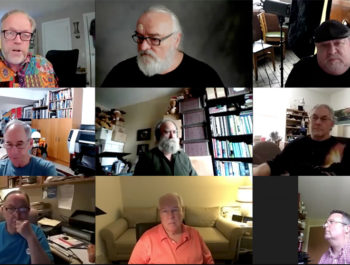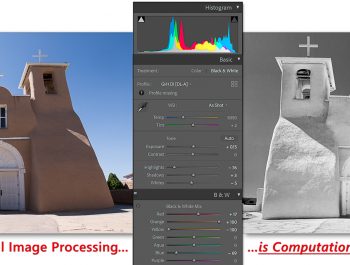Happy Birthday Digital Imaging
By Jeff Schewe
Thirty years ago on February 19th, 1990 the age of digital imaging began. Oh sure, there were earlier implementations that manipulated images digitally, but it was on February 19th, 1990 that Photoshop 1.0 shipped and that gave birth to the democratization of digital imaging. The early machines like the Scitex or Quantel Paintbox cost hundreds of thousands of dollars and were hard to learn to use. But Photoshop cost a paltry $895 and could run on home computers like the Macintosh IIfx for under $10,000. Photoshop put digital imaging in the hands of artistic individuals instead of big companies.
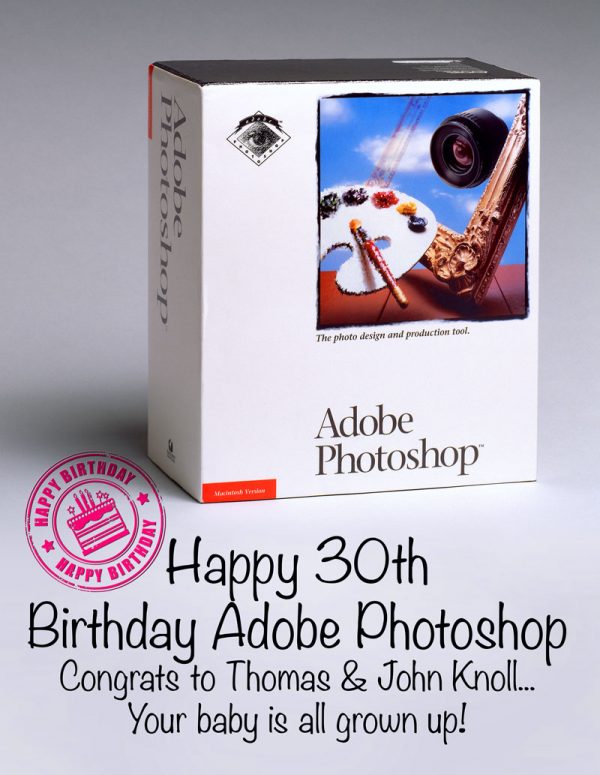
February 19th 1990 – Photoshop 1.0
So, it was on February 19th, 1990 that Photoshop 1.0 shipped…we think. It seems nobody at Adobe was exactly sure what day in February 1990 that Photoshop boxes went out the door. Kevin Conner, then an Adobe executive dealing with pro imaging and responsible for organizing a celebration contacted me a couple of months before February 19th, 2010 to ask if I knew when Photoshop shipped. It seems nobody in Adobe corporate knew. But since I had written an article about the history of Photoshop for Photoshop’s 10th birthday, he thought I might know. Well, I didn’t, but I asked the one guy who might know, Thomas Knoll, the co-father of Photoshop. Thomas picked the 19th because it was a Monday and next to the last week of February so that was his logical guess. Thomas’ guess is good enough for me! But remember the day, February 19th because you’ll see later in the article how important that day has become to digital imaging.
I mentioned Thomas Knoll is the co-father, the other father is, of course, John Knoll of Industrial Light and Magic fame. In case you may have been living under a rock the last 47 years, ILM is the special effects arm of Lucas Arts the film production company started by George Lucas that produced Star Wars. In fact, an argument could be made that Photoshop is a direct descendant from Star Wars. It was John Knoll, while working on high end proprietary file formats from various computer systems, who asked his brother Thomas for help which gave rise to Photoshop. It started out as a simple graphic file format utility! The other reason George Lucas plays a role in the story is that I’ve been told that John Knoll’s employment contract basically meant that anything John created was owned by Lucas Arts.
So, the head of Lucas Arts had to sign a waiver to allow John and Thomas to license Photoshop to Adobe. It seems nobody thought there would be much desire for regular folks to use digital imaging on PC’s. They were, of course, wrong… but George was famous for allowing cool bleeding edge technology to slip through his fingers. It seems he made enough money on big blockbuster movies to let his talented employees benefit from their own creations. Thanks for Photoshop George.
-

Thomas Knoll -
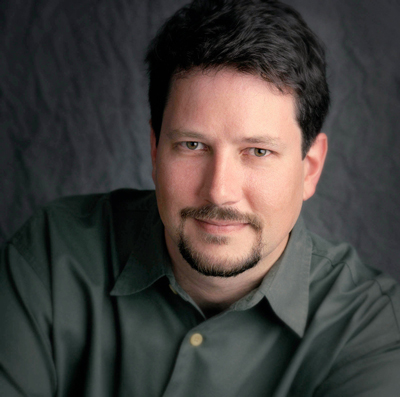
John Knoll
If you wish to read the early history of Photoshop from 1990 through 2000, you are welcome to download the PDF from my website at http://schewephoto.com/pei/. Also included is a story about the making of the cover and a short story about me from 20 years ago!
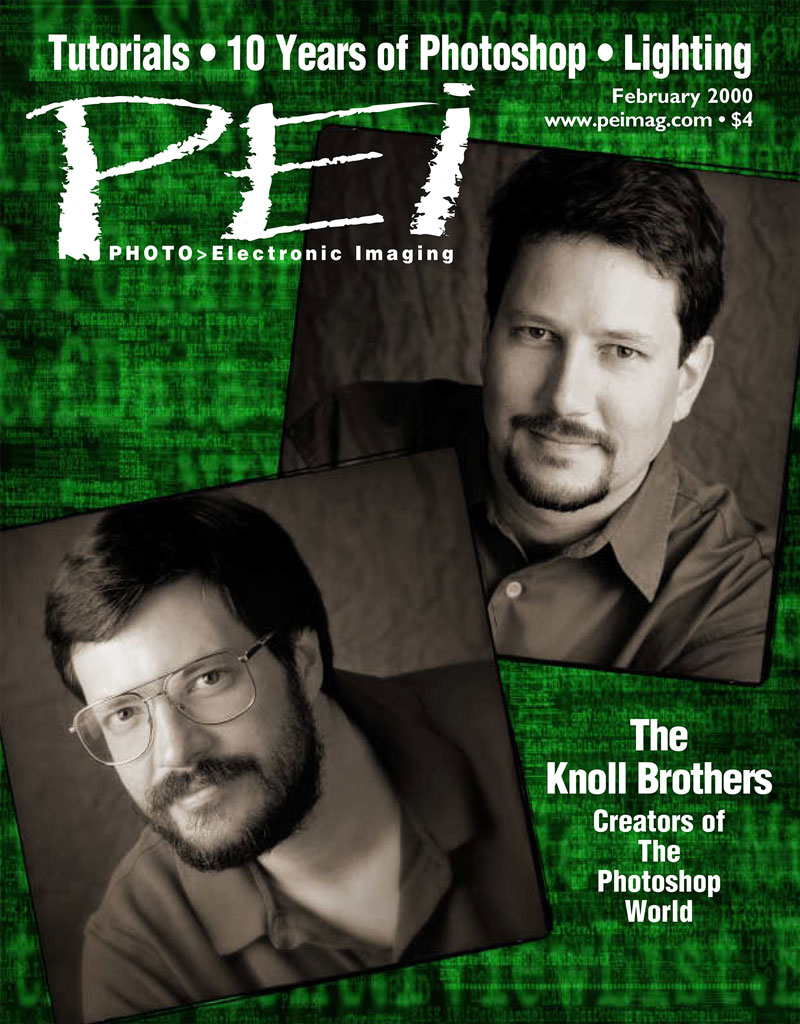
If you read through my article you’ll see there were a number of people who came after Thomas and John including the always effervescent Russell Preston Brown as well as Photoshop’s first product manager Steve Gutman.
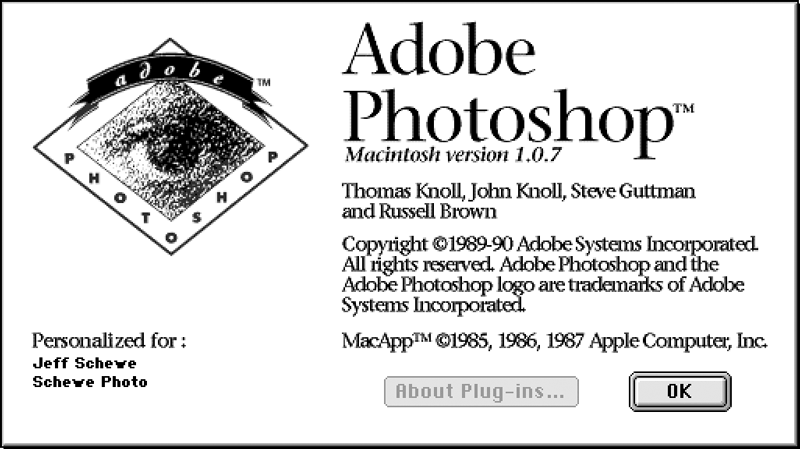
However, there’s another person who should share the stage with the Knolls and that’s Mark Hamburg, the number 2 engineer hired to work on Photoshop as software engineer. Over the years it was Mark who probably wrote more lines of code than any other engineer and sort of took over as the guiding hand of the technical development of Photoshop.
-

Mark Hamburg
I was pleased to learn that last year, the Academy of Motion Picture Arts and Sciences awarded Thomas and John Knoll as well as Mark Hamburg Scientific and Technical Achievement Awards. The SciTech awards are sometimes referred to the Nerd Oscars. But I think it was a well-deserved award considering what Photoshop has brought to us. If you want to see the award presentation by actor David Oyelowo and Thomas, John and Mark’s acceptance speeches, you can watch on YouTube in this video 2019 Sci-Tech Awards: Thomas Knoll, John Knoll and Mark Hamburg
(notice the grey hair-Photoshop will do that to ya)
I suspect many of you who may be reading this are more recent Photoshop addicts. In the early days, Photoshop was a nerd product for digital imaging and graphic design types. It’s really only since the advent of digital cameras in the early 2000’s that photographers started using Photoshop in mass. So, if you never seen just how limited and primitive Photoshop 1.0 really was, I have a treat for you. About 10 years ago when Russell Brown took his show on the road to Japan he asked me if I could do a video demo of Photoshop 1.0. Mind you this is not an easy ask. First off, one needs a copy of Photoshop 1, which I had because John Knoll gave me a copy.
Second, Photoshop 1.0 won’t run on current hardware/software. The last version of OS X that could run Classic was system 10.4.x. If you don’t know what Classic is, well, you don’t have the battle scars of long-term imaging veterans. Classic was the old System 9.x in use before Apple switch to OS X. It just so happens, I have an old G4 laptop that I’ve locked down to OS X 10.4 just so I can run old legacy apps like Photoshop 1.0.
February 19th, 2003 Adobe Camera Raw (ACR)
When Kevin Conner asked me about the date Photoshop 1.0 shipped, February 19th kinda clicked in my head. It was February 19th, 2003 while at a Photoshop World in LA that Adobe shipped Adobe Camera Raw (later dubbed ACR by everybody but Adobe). The original price was $99 and available as a software download only–Adobe’s first such online sale and fulfillment. The plug-in would only work in Photoshop 7.0.1 and it allowed people with digital cameras to process their images shot in a raw file format and open them into Photoshop. Now this might not seem like a big deal these days, but remember 2003 was early in terms of digital cameras. I remember when I got my first digital camera, a Canon D30, I only vaguely understood the differences between shooting in a raw format vs JPEG. I remember talking to Jay Maisel about raw file formats and he said he didn’t use them, didn’t need to. He captured his images with the “proper exposure” and didn’t want to do post processing and besides, JPEG were better because he could “get more images on a camera card”. I swear that is what he told me. Of course, he shoots raw now!
Back then being able to open raw images into Photoshop while being able to adjust white balance and exposure was a huge boon to digital photographers. Why? Well, to put it mildly the raw processing software provided by the camera companies sucked eggs, big time. I mean, it was really terrible–which was why Thomas Knoll decided to do something about it. Thank goodness for Thomas once again! You see, Thomas is actually quite a good photographer. He’s traveled to faraway places and enjoys carrying huge friggin’ lenses around, and darn if he doesn’t come back with good stuff. Please check out his web site to see just how good Thomas is. http://www.tknoll.com.
So, Thomas had bought a Canon D60 just before a family trip to the Tuscany region of Italy. FedEx arrived with the camera just in time so Thomas packed the camera and loaded the Canon software on his laptop to process raw files (he knew better than to shoot JPEGs). The only thing is Thomas didn’t like the Canon software very much so I’ve been told the start of what would become ACR started on that trip. It was a week in June of 2002 and ironically the same time that I was putting on an all day seminar in New York City called Digital Imaging for Photographers (DIFP). I had Bruce Fraser to talk about color management, Andrew Rodney to talk about scanning and printing and I talked about Photoshop and imaging aimed at photographers. I also arranged to have some friends on a panel discussion at the end of the day including; Barbara Bordnick, Douglas Dubler, Jay Maisel, Jack Reznicki, Melvin Sokolsky, and Stephen Wilkes. Some pretty big names, right? The irony is the biggest complaint from the panel as well as the audience of photographers was why the hell couldn’t Photoshop open raw files from digital cameras? Everybody agreed that the camera companies’ software sucked.
Since Adobe was a sponsor of the event, a Photoshop product manager was sent to learn what the hot topics of the day were from the New York photographers. Well, poor John Nack, a new PM, learned the hard way that Adobe was seriously needing some sort of solution to open raw files and they needed it in a hurry. Adobe even had begun negotiating to buy a company well known as a 3rd party raw processor. But it seems when Thomas returned from his Italian trip he was already on the way of providing a solution–a plugin he called Camera Raw.
Later in the summer, I talked with Thomas about Camera Raw. He wanted feedback on some of the technical aspects of the plug-in and offered to send a plug-in to test. The only problem was I didn’t have a D60, only a D30 and thus began one of the biggest thorns in Thomas’ and Adobe’s sides, each friggin’ camera needs it’s own friggin’ support which means “somebody” had to decode every raw file format from every camera to add support in Camera Raw. Since Thomas didn’t have a D30, I offered to ride my motorcycle over to Ann Arbor, MI to let him shoot some raw files for decoding.
-
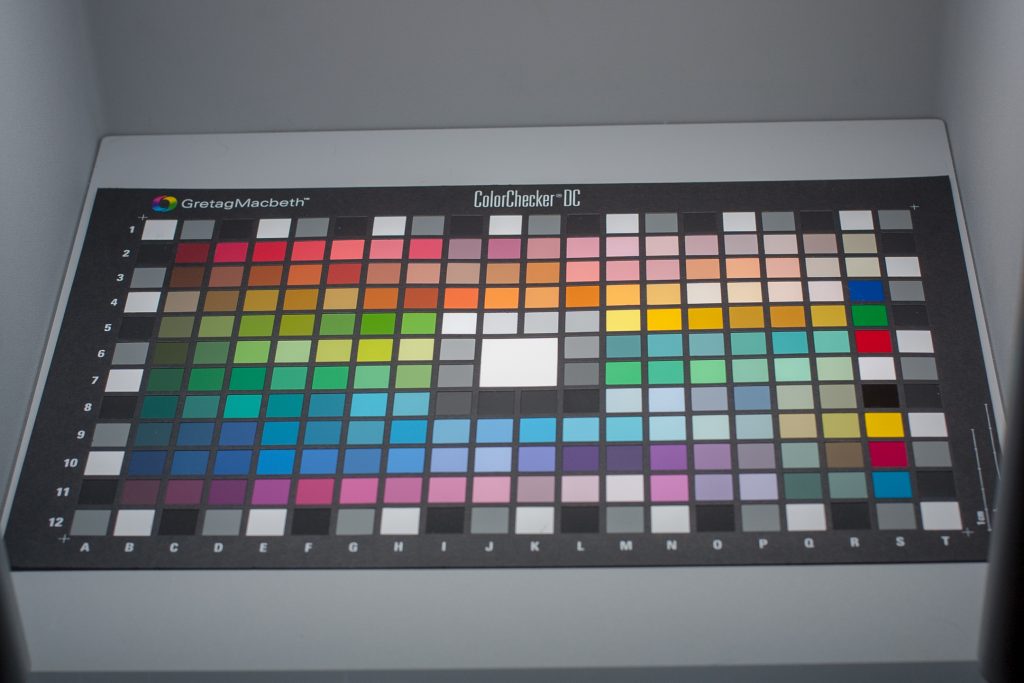
D30 raw daylight capture -
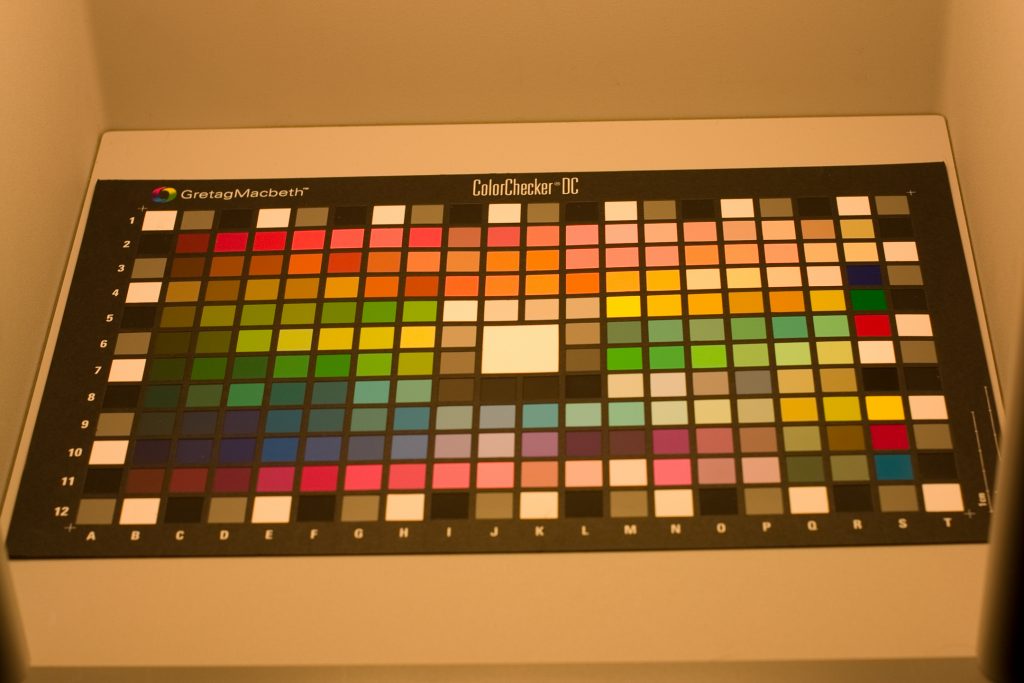
D30 raw tungsten capture
The images above are the actual shots Thomas took with his GretagMacbeth SpectraLight Jr. The process he used was to make changes on the camera for various settings such as ISO and white balance and then look inside the metadata of the raw file to guess what the settings were and where they are stored. This is a tedious process which of course is something Thomas excels at. He’s perfectly happy putting his legs up and placing his laptop in, well, his lap and working…often for hours on end to arrive at the final solution. If you think I’m kidding, here is an example shot of Thomas in his favorite programing position.
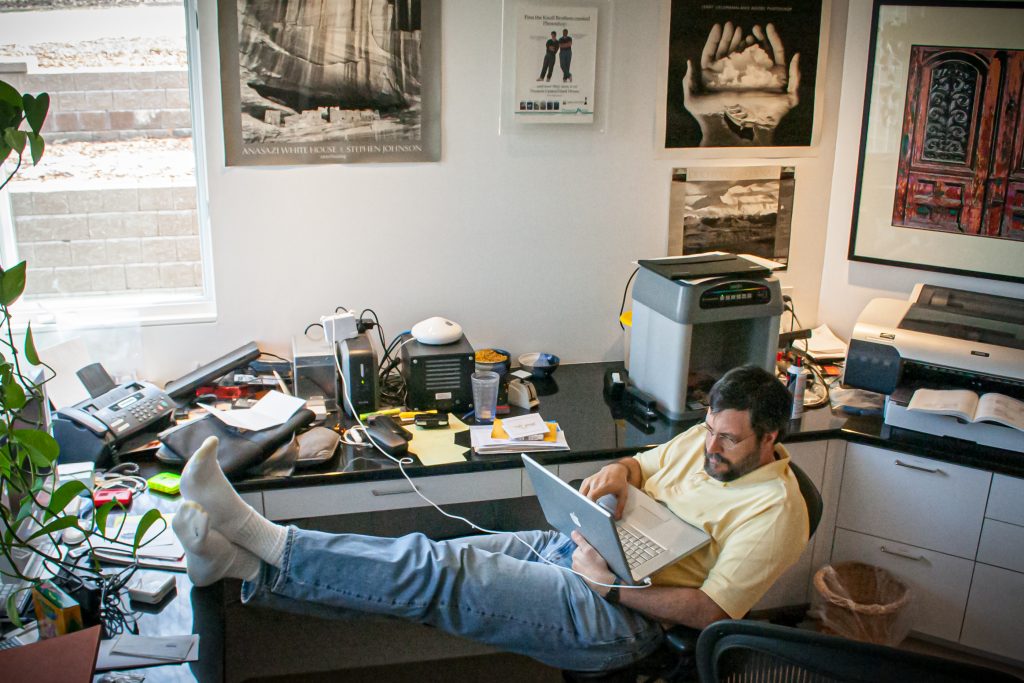
You’ll notice that right behind Thomas’ head is his SpectraLight Jr that many cameras have been profiled with. In recent years Thomas and the Camera Raw team (which has expanded to more people) have some more elaborate equipment for testing cameras. But each camera does still have to be individually tested–which is a pain in the arse–which was one of the reasons Thomas came up with the Digital Negative or DNG file format. That and to teach the camera company engineers how to create a well formed and proper raw file format and how to safely store metadata in the files.
After my trip to visit Thomas, I arranged for a bunch of my photographer friends to get access to beta versions of Camera Raw to test. Seth Resnick, Greg Gorman, and many other Canon shooters and even a couple of Nikon shooters. We worked with Thomas to test out the processing controls and how best to optimize the final rendered image in Photoshop. But there were some political issues that came about that fall. While Camera Raw worked in Photoshop 7, there were some at Adobe that wanted to wait almost a year until Photoshop CS was due to be released. Well, that would be less than optimal…we wanted Camera Raw NOW! So a small contingent of testers and certain Adobe people (names withheld to protect the innocent) prevailed upon the powers that be to put Camera Raw into the marketplace ASAP and heck, even charge for it. Which lead to Camera Raw being released on Wednesday February 19th, 2003 at Photoshop World LA.
I remember because Greg Gorman threw me a 50th birthday (on the 22nd) at his house and all my photo and Adobe friends showed up! Camera Raw was a very nice birthday present, thanks Adobe…you can read the original press release from Adobe on DPReview’s web site Adobe Camera RAW Press Release it even has a quote from some photographer in Chicago who said “The coolest thing about the Photoshop Camera Raw plug-in is the white balance feature,” said Jeff Schewe, award-winning advertising photographer, and one of just 65 photographers worldwide to be named a Canon Explorers of Light. “Now photographers can adjust their images in terms familiar to them, quickly and accurately. Also, the ability to see a preview of the sharpening and smoothing is great. Photographers will love the raw format capabilities in this new plug-in.”
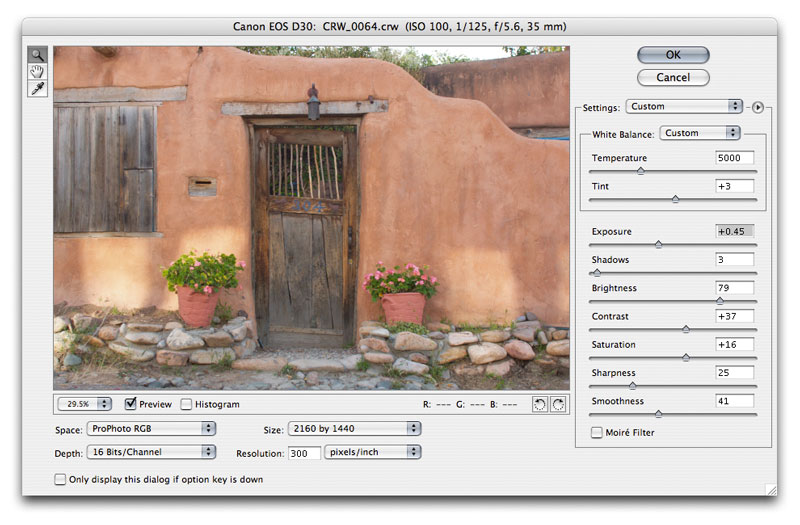
Camera Raw has been a huge success for the digital photography industry, but it wasn’t all rainbows and unicorns. Photographers constantly complained that Adobe took too long to support their just released new cameras. It seems that the camera companies weren’t too friendly to Adobe and the Camera Raw initiative.
The camera companies wanted control over their own proprietary raw file formats and didn’t want to disclose any secrets to some San Jose software company. All the camera makers–Nikon and Canon in particular–wanted to control “the look” of the raw capture processing because they thought the look was something they could compete on. What they didn’t want was some software engineer to come along and attempt to normalize raw file formats from a variety of cameras so they all sort of looked the same at “default”.
Thomas decided early on that rather than try to optimize for each and every camera, he would endeavor to normalize raw file processing and let the photographer optimize to satisfy their own taste. Which is also one of the reasons that Camera Raw often lost out on certain raw processing shoot outs because rather that try to make an image look better pumping up saturation, contrast and sharpening, Camera Raw tended to put out softer less contrasty and desaturated color images. Personally I fully support Thomas’ original approach of normalizing rather than optimizing because I prefer to get in there and rub my own pixels together. But I see the camera companies’ point of view. However, that’s not a good enough reason to dump all these raw file formats on us nor to have to wait until Adobe (aka Thomas or Eric or Josh or Max or whoever drew the short straw) got a physical camera and could run test shots and decode the raw file and metadata. And that’s assuming somebody at the camera company didn’t accidently/on purpose encrypt some important metadata in the raw file.
Anybody remember the “Encrypted White Balance” debacle?
Seems some software engineer while trying to make sure their own software could read the white balance metadata in the camera file took the unexpected step of encrypting the data. The intent we are told was simply to make sure their own software could read the metadata but it also drew a line that Thomas didn’t want to cross. Contractually, decrypting anything in a raw file could be seen as being a copyright violation based on the Digital Millennium Copyright Act (DMCA). Thomas posted this on the Adobe User to User Forums:
“They decided to ENCRYPT the white balance data inside the raw file for these cameras. Previously, the white balance data was stored in non-encrypted format, and was readable to third party raw converters using simple reverse engineering of the file format.
While any encryption system that stores the decryption key inside a PC computer program (vs. having the user type in a decryption key) is fairly easy to crack (Bibble has already broken the encryption algorithm), it does raise legal obstacles. The camera company might consider breaking the white balance encryption a violation of DMCA, and sue Adobe.”
Well, the fur flew…this was an article I posted on PhotoshopNews
The company responded but it didn’t really go over very well. I happen to know that the American office was getting a lot of heat from Japan. At the time, if you did a Google search, the top topics relating to the new camera was all about the white balance encryption. Somebody from the company (I know who) called somebody at Adobe (I know who) and said, what do we do to make this all go away. The answer was for the company to create a special White Balance Decryption mini SDK that would allow Thomas to decrypt the white balance data and fully support the new camera. That company in particular and the camera industry in general, learned a valuable lesson that day. Don’t f@#k around with Thomas Knoll!
We still have the Tower of Babble where new cameras spawn new proprietary raw file formats but the camera companies have learned some valuable lessons from Thomas and Adobe; don’t encrypt data if you want camera support, get cameras to Adobe ASAP so Camera Raw and Lightroom can support the new cameras and try to use best practices when creating raw file formats. Even if most camera companies don’t use DNG, they have learned how best to store common and proprietary metadata in the file. In fact I happen to know for a fact most recent cameras that capture raw file formats could be converted to offer DNG as an option which likely won’t happen. The irony in the Tower of Babble scenario is that it makes the long term preservation and conservation of digital files more risky for future support. The US Library of Congress is seriously concerned about the long-term viability and preservation of digital objects of all types including text files, sound and video files and of course digital photography. If you want more info, check the Digital Preservation at the Library of Congress web site .
As you can see, the current practice of relying on undocumented, proprietary raw file formats is less than optimal for long term viability and preservation which is one reason that the LOC looks favorably on DNG and Adobe has even offered DNG to the ISO to be included in the TIFF-EP ISO 12234-2 (TIFF-EP is TIFF for Electronic Photography). Sadly the last update to that standard was in 2001 so I wouldn’t hold your breath. Too bad really since pretty much all of the raw file formats adhere to TIFF-EP standards and could easily be used by the camera makers. I wish photographers would be more vocal about the issue and demand that the camera companies adopt some sort of raw file format standards.
Sorry for the rant, I’ll get back down off my soapbox and get back to the topic at hand, February 19th and the importance of that date to digital imaging. There’s another Adobe product that uses the Camera Raw pipeline, Lightroom. Can you guess what day Lightroom 1.0 shipped? If you guessed February 19th 2007 you would be correct!
February 19th, 2007 Lightroom
Lightroom was the brainchild of Mark Hamburg, you remember, the second engineer to work on Photoshop? Photoshop 7.0 was the last version of Photoshop that Mark worked on. He had come to the conclusion that the heyday of Photoshop was over and Adobe’s decision to clump Photoshop into the Creative Suite would be the end of Photoshop’s supremacy. So after Photoshop 7 shipped, he “washed his hands of Photoshop” and went looking for something else to do at Adobe.
Mark was an “Adobe Fellow” a title given to particularly important and gifted engineers. The title comes with status, staff, and some sort of budget so Mark could “play” with whatever he wanted to. Over the years, Mark and I had developed (pardon the pun) a pretty good working relationship. When Mark was looking for a way to incorporate multiple undo in Photoshop he had seen a demo I gave at a Seybold seminar using Photoshop 2.5. He was impressed with the ability to blend various images back and forth. So when Mark was tasked with adding multiple undo into Photoshop 5, he thought of my demo and envisioned multiple undo as History in Photoshop.
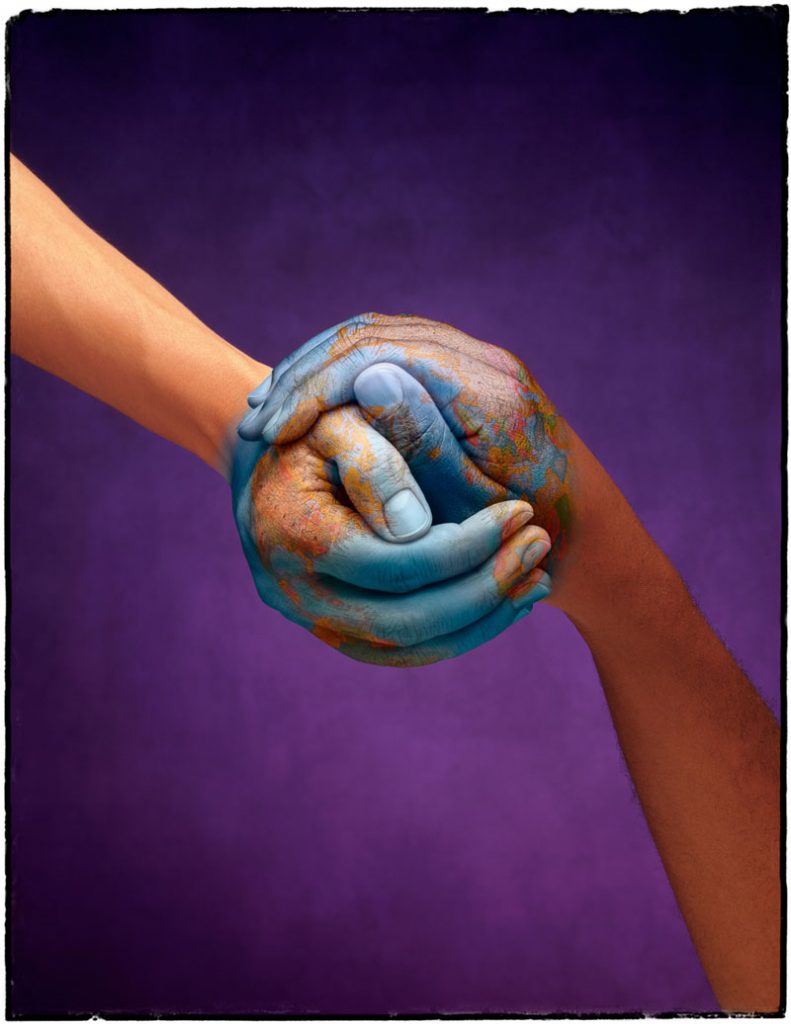
Actually, a lot of my ideas had found their way into Photoshop starting with Photoshop 3 when I was first added as a beta tester. I first met Mark online during the Tuesday night Photoshop Chat on AOL (I’m dating myself with that admission). Tuesday night people would log on to meet up and talk, well, type about Photoshop. The chat was hosted by Kai Krause of Kai’s Power Tools fame. It was quite the gathering place. John and Thomas Knoll would sometimes stop by to chat. Hamburg was a regular as well. So, I pestered Mark because I was having an issue with Photoshop. I was using Gaussian Blur and getting corrupted data at certain radius settings. I was able to document exactly what radius setting would trigger the corruption and that allowed Mark to easily track down the bug. So I had passed some sort of “usefulness test” with Mark (which meant he would actually listen to me if I said something).
The Photoshop 5 period was one of my most productive working with the engineers. So much so that they asked me to create the secret “Beta Splash Screen”. One accesses the beta screen by holding down the option key when going to the About Photoshop menu item. On windows it’s the control key. In addition to doing the splash screen my name was listed in the scrolling credits for Creative Input. I found out later that Mark had his name on the patent Adobe filed for Photoshop’s History/Multiple Undo and got a nice little financial benefit. All I got was a Photoshop feature designed specially for me. I figured it was a fair deal.
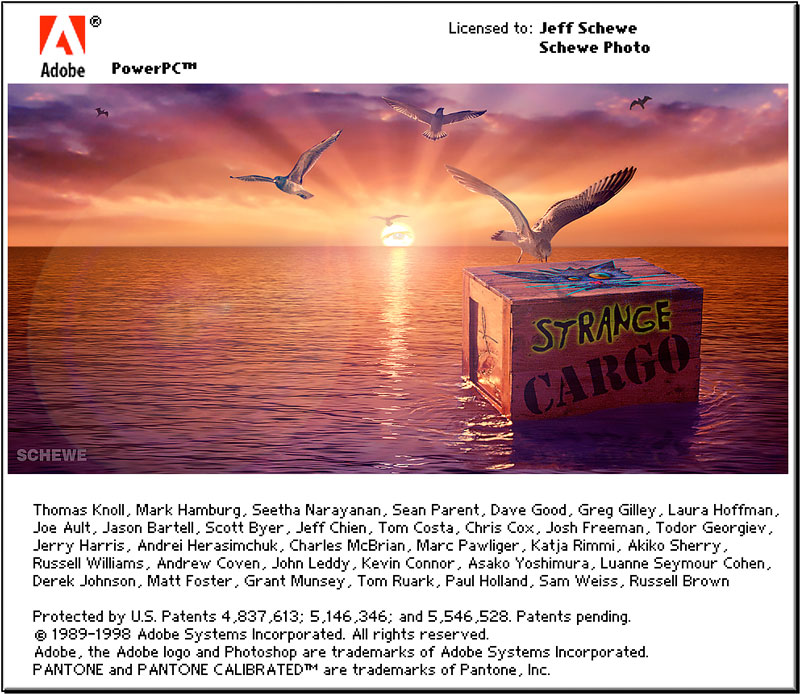
Sorry for the digression, but I wanted to give some background why when Mark started working on a “sand box” project he thought of contacting me to play in his sand box. I won’t dwell on the remainder of the story because you can read all about it on PhotoshopNews.com in The Shadowland/Lightroom Development Story.
Exactly why PhotoshopNews.com is still online is somewhat a mystery to me. Although I started it as a PixelGenius.com project, I let the site lapse because I simply couldn’t keep a blog like that going. So, PG decided to let the domain lapse. Somebody picked it up and hoovered the whole site and keeps it going. The domain registrant seems to be hidden. Oh well, it’s useful for this purpose.
So, do you wonder where I was when Lightroom 1.0 actually shipped? I was on a ship in the waters around the Lemaire Channel in Antarctica. In fact a number of us involved in Lightroom beta testing were down there including Michael Reichmann, Seth Resnick, Bill Atkinson, and JP Caponigro. Even our PhotoPXL host Kevin Raber was down there with us on the ship although he didn’t go with us on the special Lightroom 1.0 Birthday Cruise to make a this video.
I’ve explained why I think February 19th is an important date in the grand scheme of things. I think it somehow poetic that at a time when the last Star Wars movie Episode IX – The Rise of Skywalker is still playing in the theaters Photoshop turns 30, Camera Raw turns 17 and Lightroom turns 13 years old. I sometimes wonder if there’s some sort of cosmic reason why February 19th has been chosen as this important date in digital imaging’s history but alas, I think it’s simply a really cool coincidence.
So, happy birthday Photoshop, Camera Raw and Lightroom and happy birthday digital imaging…may you have many happy returns!
Jeff Schewe
Chicago, Illinois
Jeff Schewe has been an award winning Advertising Photographer in Chicago for over 30 years. He is accomplished in tabletop, location, portraiture and particularly accomplished in computer imaging. Jeff shoots a variety of subject matter and likes to control as much of the production as possible. He does this by making his own models, designing and building his own sets, painting backgrounds and employing computer imaging. He has been doing his own imaging for almost 20 years in house on his high-end Macintosh systems. Jeff Schewe has been described as a Photoshop Guru’s Guru. He’s on the inside of the development and testing of Photoshop, Camera Raw and Lightroom and has helped guide and direct many features since Photoshop 4.0. Short of some of the Photoshop engineers, there’s probably not many people who knows Photoshop like Jeff. As an indication of his skills and knowledge of fine art printing, he has been named an Epson Stylus Pro. He is a past Apple Master of the Medium and has been inducted into the Photoshop Hall of Fame (2006).







